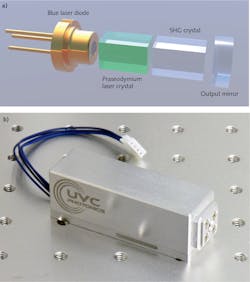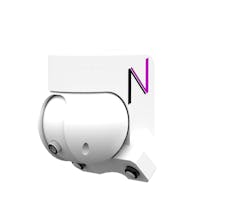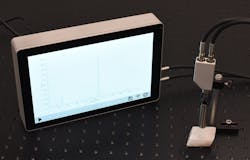Compact deep-ultraviolet CW lasers lead to new commercial applications
Continuous-wave (CW) lasers in the deep-ultraviolet (deep-UV) spectral range (λ <300 nm) are useful for many applications, including Raman spectroscopy, fluorescence microscopy, optical testing, and sterilization. This type of laser has traditionally been constructed by frequency quadrupling of near-infrared (near-IR) neodymium lasers with a wavelength near 1 µm. Because this architecture requires a single-frequency fundamental laser and one, in the case of intracavity second-harmonic generation (SHG), or two sensitive external resonant cavities for frequency conversion, these systems have been largely confined to research laboratories. As a result of this complexity, even the most compact devices are the size of a shoebox, which essentially prevents their use in portable or handheld instruments. Over the past several years, UVC Photonics (Helsinki, Finland) has been developing CW deep-UV lasers based on praseodymium with a form factor and ruggedness typically associated with diode lasers.
History of praseodymium lasers
Praseodymium is by no means a new visible-laser ion, as the first demonstration of blue laser emission at room temperature from praseodymium in a yttrium lithium fluoride (YLF) host dates back to 1977.1 In that experiment, the pump source was a pulsed excimer-laser-pumped dye laser, resulting in a system that was neither compact nor practical for development into a commercial product. Two decades later, the first room-temperature CW visible emission was demonstrated with an argon-ion laser as the pump source.2 Again, this was an architecture only suitable for laboratory studies. In 1998, the first all solid-state praseodymium laser was demonstrated at red, green, and blue output wavelengths.3 This was a big step in the direction of compact lasers, but still required a flashlamp-pumped solid-state laser as the pump source.
Around the same time, the first blue-emitting laser diodes were under development. This offered hope for compact praseodymium sources operating at several wavelengths in the visible, with the potential for SHG to the UV. However, it would take several more years for the output power of blue diodes to reach a level suitable for use as a pump source, and the first diode-pumped praseodymium lasers were demonstrated in 2004.4 The output powers of these first lasers were only a few milliwatts, but the blue-diode pump sources were improving rapidly, driven largely by the display market for use in projectors. Within a few years, laboratory demonstrations of CW output from praseodymium-based lasers had risen to the level of several hundred milliwatts at wavelengths throughout the visible and UV.5
Despite what looked to be a promising future for praseodymium lasers, commercial systems were rare, and those that did appear were short-lived. This can be explained in part by the rapid advance of visible direct-diode technology. By the early 2010s, diodes were available with watt-level CW output power at red, green, and blue wavelengths. Although the beam quality from these devices was generally inferior to that available from solid-state lasers, they were suitable for a large majority of applications and their simplicity and cost could not be competed with.
The other reason for the lack of a surge in praseodymium-based lasers is more scientific in nature. Although it is rarely mentioned in the literature that details the excellent laser results, praseodymium-doped fluoride crystals are exceptionally difficult to grow with the quality and consistency required for a commercial product. UVC Photonics crystal-growth experts have been growing fluoride crystals for more than 50 years. In fact, they grew the crystal used in the previously mentioned initial laser demonstration in 1977. It is this experience that eventually resulted in material purification and growth processes to achieve the repeatability required for laser products.
Making praseodymium lasers commercially viable
At first glance, the optical configuration of our deep-UV lasers appears very similar to the once-ubiquitous green laser pointers based on frequency-doubled neodymium-doped crystals. They consist simply of a single-emitter pump diode, laser crystal, nonlinear crystal, and output mirror (see Fig. 1). The laser is designed to operate at a fundamental wavelength of 522 nm; intracavity frequency doubling results in an output wavelength of 261 nm. However, in addition to the material-growth challenges, there are subtle differences that complicate the situation.
The first relates to the pump diode. Praseodymium in YLF has an absorption maximum at 444 nm with a relatively narrow bandwidth of about 1 nm; this means the pump-diode wavelength at the desired operating current should also be 444 nm. In neodymium lasers, which are pumped near 808 nm, it is common practice to achieve this by varying the diode temperature. The wavelength shift with temperature for near-IR diodes is about 0.3 nm/°C. Given the typical variation in free-running center wavelength from diodes of ±5 nm, this is easily achieved without excessive temperature tuning. However, for blue diodes based on gallium nitride (GaN), the temperature-tuning coefficient is much smaller, with a value of about 0.09 nm/°C. Given the same typical variation in center wavelength of ±5 nm, this implies the potential need to tune over as much as ±50°C to match the wavelength to the crystal-absorption maximum. Clearly this is impractical in a compact device, so other means are required to achieve the desired outcome.
One option is to hand-pick diodes with the correct wavelength, but this is expensive and time-consuming. The few manufacturers of blue diode lasers are also understandably reluctant to cooperate on this, as their focus is on the millions of units per year sold into the display and lighting markets. Even the most optimistic projections for deep-UV lasers do not begin to approach these volumes. A second option is to provide wavelength-selective feedback to the diode to force it to run at 444 nm. There are a number of ways to do this, including an external angle-tuned diffraction grating, a wavelength-selective coating on the crystal, or a volume Bragg grating (VBG). Of these choices, a VBG is the most compact and robust option.
The second difference when compared with a green laser pointer relates to the laser crystal itself. In commonly used neodymium crystals such as yttrium aluminum garnet (YAG) or yttrium orthovanadate (YVO4), the thermal lens induced by end-pumping with a diode has a positive focal length that is dependent on the pump power and beam parameters. For a short linear laser, this has the effect of stabilizing the laser cavity. In fact, in the majority of the laser-pointer devices, the optical surfaces of the cavity are flat. Cavity stability is obtained entirely from the pump-induced thermal lens. In praseodymium-doped YLF, the situation is the opposite: the pump-induced thermal lens is negative. This has the effect of destabilizing the cavity if the optical components are not designed to counteract this. In practice, this means curved surfaces are required on the laser crystal or output mirror, or both. With a proper choice of curvatures, the laser cavity remains stable over the pump power range of interest.
When the details above are taken into account, it is possible to construct very compact and low-cost deep-UV lasers. The standard device from UVC Photonics measures only 22 × 24 × 71 mm in size and operates as if it were a direct diode laser. Current is applied to the pump diode and deep-UV light is emitted. There are no complicated electronics required to lock cavities or provide precise temperature stabilization as in previous frequency-quadrupled neodymium lasers. As a result, many devices and applications are enabled that could not have been considered in the past.
Example uses of compact deep-UV lasers
Over the past year and a half, there has been a large increase in interest in sterilizing or disinfecting surfaces and objects encountered in our day-to-day lives. Utilizing deep-UV light in the UVC band is well known to be an effective technique for the inactivation of pathogens. Mercury lamps and, more recently, deep-UV LEDs have been employed for this purpose. Both of these light sources lack the beam quality that can be obtained from a laser; as such, they are used in a flood-illumination mode. Although effective, this is not a very efficient approach, particularly because it is known that pathogens are concentrated on objects that people frequently touch such as door handles, elevator buttons, and so on. With flood illumination, walls and ceilings receive the same UV energy as high-touch objects, which can essentially be considered as waste. In addition, these systems cannot be used when people are present due to the potential hazards of deep-UV light. NeuraViolet is developing a next-generation deep-UV sterilization system using a compact praseodymium laser (see Fig. 2). The device is similar in size to a typical roof-mounted pan-tilt security camera. Preprogrammed targets can be sequentially illuminated with the laser while sophisticated artificial intelligence software ensures safety for people in the environment.Another emerging application is a fluorescence-microscopy technique known as microscopy with ultraviolet surface excitation (MUSE). With the MUSE technique, the time-consuming steps related to tissue sectioning are not required to be performed in order to obtain high-quality fluorescence images. MUSE has typically used deep-UV LEDs for illumination, but their poor beam quality and low brightness has limited microscope magnifications to the range of 10x. With a compact deep-UV laser source, higher magnifications can be used and hence sample detail can be improved to compare with traditional fluorescence microscopy techniques.
UV Raman spectroscopy has long been recognized as a powerful technique for molecular studies and material identification. However, the lack of compact deep-UV lasers has kept UV Raman almost exclusively confined to research laboratories. Using deep-UV light for Raman spectroscopy has several advantages. Signal strength in Raman spectroscopy is proportional to the inverse of the fourth power of the excitation wavelength, so moving to the deep-UV offers much higher signal-to-noise than Raman systems at more-traditional wavelengths such as 785 nm. Also, in many materials there are resonance effects due to coupling between electronic and vibrational transitions, which can increase the signal by an additional factor of up to 105. Another benefit is that by moving to an excitation wavelength deep enough into the UV, sample fluorescence, which can cause issues using traditional excitation wavelengths, is avoided. Spectralence has developed the first portable battery operated deep-UV Raman system using a laser based on praseodymium (see Fig. 3). It has applications that include mining, semiconductors, general materials science, and detection and identification of explosive and other hazardous materials.The above are just a sample of applications, with new ones developing as the integration of these types of compact lasers progresses.
REFERENCES
1. L. Esterowitz et al., J. Appl. Phys., 48, 650 (1977).
2. T. Sandrock et al., Appl. Phys. B, 58, 149-151 (1994).
3. S. C. Buchter et al., “Advanced Solid State Lasers,” OSA Trends in Optics and Photonics Series, Optical Society of America, paper VL1 (1998).
4. A. Richter et al., Opt. Lett., 29, 22, 2638–2640 (2004).
5. A. Richter et al., Opt. Express, 15, 8, 5172–5178 (2007).
Scott Buchter | Co-founder, Outsight and UVC Photonics
Scott Buchter is co-founder of Outsight (Paris, France; www.outsight.ai) and UVC Photonics (Helsinki, Finland).


